Saturday August 19 in Sauk County-Badger Steam & Gas Engine Show and Mid-Continent Railroad Museum
I took a little day trip to Sauk County yesterday for the Badger Steam & Gas Engine show in Baraboo, and then afterward paid a visit to the Mid-Continent Railroad Museum in nearby North Freedom. My family and I have been going to the Badger show for quite a few years now. It features large exhibitions of antique steam, gas and diesel engines and vehicles, blacksmith shop and woodworking demonstrations, as well as a flea market with just about everything (sometimes even including the kitchen sink) up for sale.
We couldn't help but notice the engraving on the base of this old water-heating cauldron. It's probably not a relation, my dad was an only child and most of his father's siblings never had children.
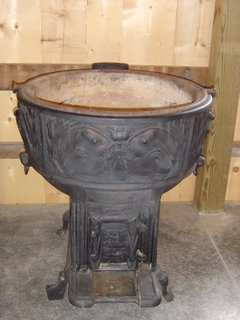


Another exhibit that caught my attention (and fit in with the later theme of the day) was this 7 1/2" gauge steam locomotive, Southern Pacific 4-6-2 #7982. This is about as small as trains can get and still be rideable-the driver rides astraddle a cushion on top of the tender and operates the engine through the cutout in the roof of the cab. This particular locomotive is fired on propane gas from a tank in the tender. It is quite detailed, right down to the AAR (American Association of Railroads) engraved on the couplers, and miniature American Locomotive Company builder's plates.


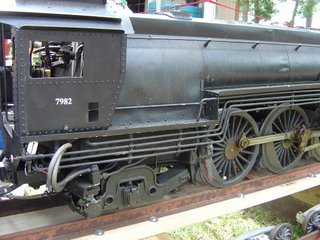

After leaving the Badger Steam & Gas Engine show, I suggested that we make the trip to the Mid-Continent Railroad Museum just down the road, which we hadn't done since 1994 (when I was 8). The museum is headquartered at the former North Freedom depot, and the exhibits stretch off in both directions down the ex-Chicago & Northwestern branch line from North Freedom to Quartzite Lake.

One of the first things you notice upon arrival at the museum is Soo Line #2645, a Brooks Locomotive Works 4-6-0. It was recently cosmetically restored and its black paint fairly gleams.
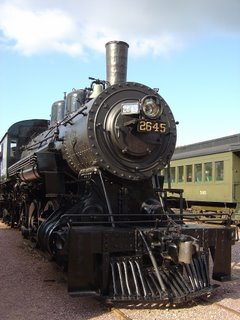
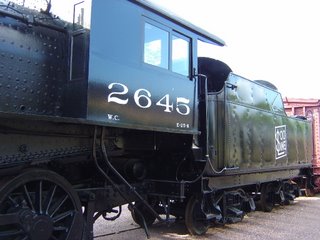
A close-up of one of #2645's Brooks builder's plates:
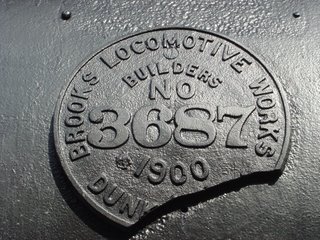
#2645's ALCO reversing gear:

Another of Mid-Continent's more prominently placed exhibits is this undercoat dull-red 2-8-0 Consolidation type, Copper Range #29. #29 is an ALCO product from 1907 and is on display in front of the Coach Shed on the south side of the street.
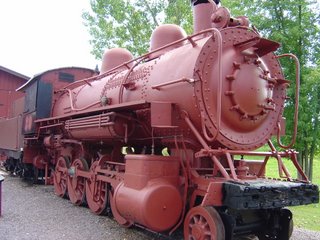

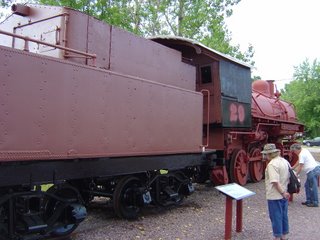
Parked directly in front of the depot is Mid-Continent's four-a-day excursion train, including Duluth, Missabe & Iron Range caboose #C74.

Also on display close to the depot is Kewaunee, Green Bay & Western 2-8-0 Consolidation #49. #49 is the only surviving steam locomotive from that railroad. It has received a new coat of paint since the last times I saw it in 1992 and 1994, although its bell and headlight have mysteriously gone missing.
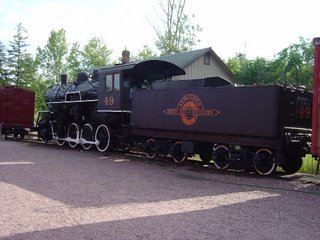
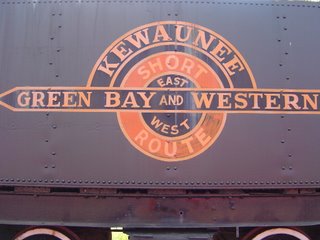
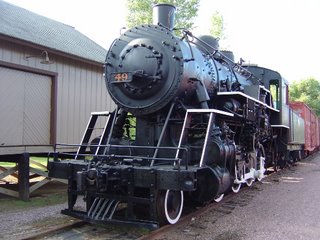
In between the main line on which the passenger train is parked and the display tracks that contain #2645 and #49 is this Dodge car modified to run on railroad tracks; together with a maintenance-of-way vehicle behind it. We photographed this car with our late Cairn terrier Harry in 1992.

Farther down the tracks on the depot (north) side of the street are two more steam locomotives on display. One is Mid-Continent's only Shay locomotive, recently cosmetically restored Goodman Lumber #9. Instead of chassis-mounted cylinders that drive the wheels directly via connecting rods, Shays have a steam engine mounted vertically on the side that drives the wheels through a system of shafts and bevel gears.
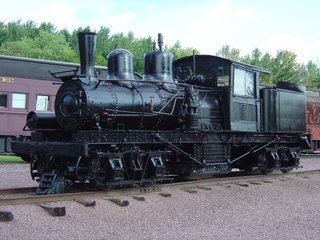
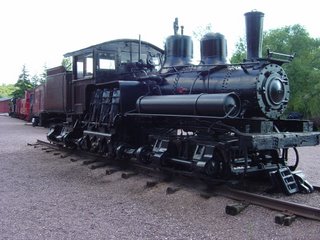
Close to the Shay is the only decrepit-looking locomotive on the north end of the museum. Woodward Iron #41, a Baldwin 2-10-0, is also the largest, heaviest and probably most powerful steam locomotive on display at MCRM.
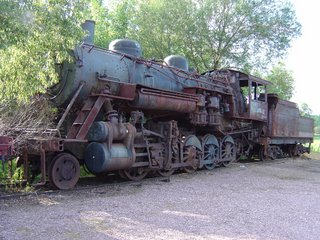

This is a steam-powered rotary snowplow from the Oregon Short Line. It contains a control cab, boiler and steam engine and requires a tender for fuel and water...but is not self-propelled and requires a locomotive to push it along.
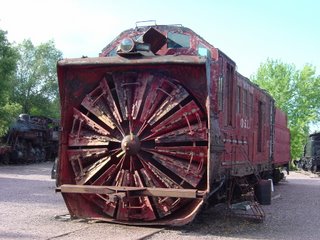
Immediately on the opposite (south) side of the street from the depot are the water tower and Coach Shed (with CR #29 in front). Close to the water tower are several freight cars on display, including a Soo Line ore car, UTLX tank car, and two steam locomotive tenders including that for Western Coal & Coke #1.
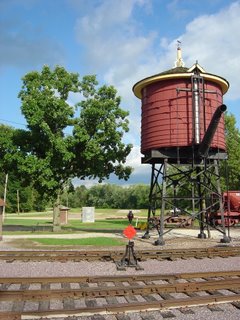
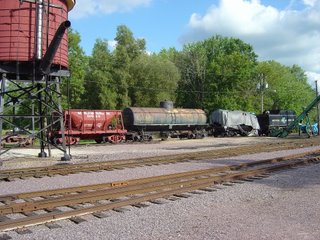
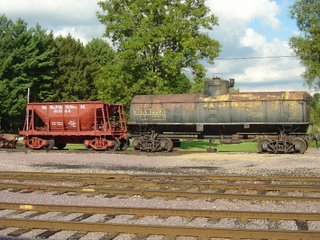
Much of Mid-Continent's fully restored rolling stock collection is protected from the elements inside the Coach Shed, including this handcar and late-19th century Soo Line boxcar.


Beyond the coach shed are several tracks containing most of the museum's unrestored and work-in-progress exhibits, as well as the locomotive maintenance and storage sheds.
A row of unmarked freight cars. The one closest to the caboose is a refrigerator car.

This ALCO S-1 diesel-electric switcher locomotive, lettered MCRY #7, is currently Mid-Continent's primary motive power.
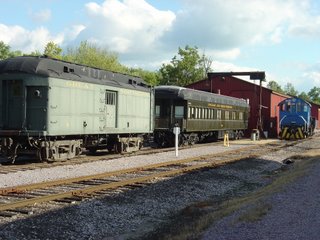
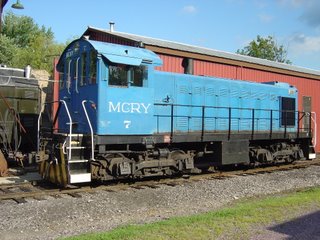
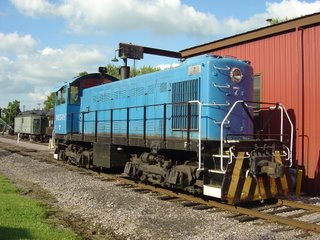
This General Electric switcher, lettered MCRY #4, is used around the Museum grounds to move rolling stock between the various sheds and display tracks.
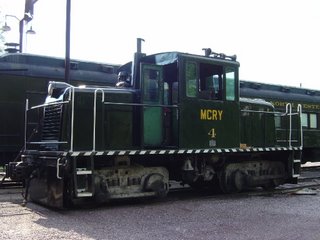
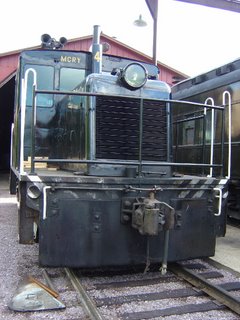
Outside the maintenance sheds is Lake Superior & Ishpeming #22, an ALCO 2-8-0 Consolidation. It is a privately owned locomotive being stored at Mid-Continent for restoration.
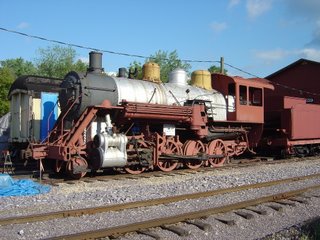

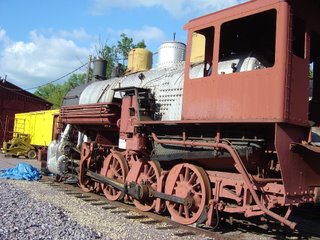
Moving further south down the myriad of storage sidings on the west side of the maintenance sheds, one comes across the largest diesel road locomotive on display at MCRM, Milwaukee Road ALCO RSC-2 #988. Diesel locomotives can be classified by their wheel arrangements like steam locomotives but the system is somewhat different. The AAR wheel configuration counts axles instead of wheels, using letters for powered axles, numbers for idler axles, and dashes to seperate trucks (swivelling wheel assemblies). #988 is an A1A-A1A locomotive, meaning the center axle on each truck is unpowered. MCRY #7 above is a B-B, meaning it has two trucks each with both axles powered.
During our trip to MCRM in 1994, the eight-year-old me was photographed on the platform of this locomotive.
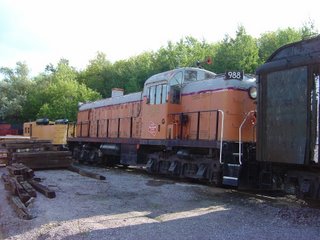
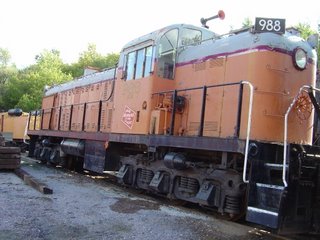
Parked next to #988 is a Soo Line crane car with flat car.

Beyond Milwaukee #988 is the oldest locomotive in MCRM's collection, Dardanelle & Russellville 2-6-0 Mogul #9. It was built in 1884 and served as the flagship of Mid-Continent's collection in the museum's early years of operation. It last ran in 1991 and has since deteriorated below operational condition, although it does appear to be the most complete and intact steam locomotive on the south end of the museum.
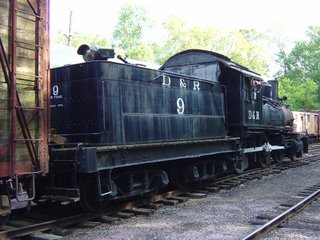
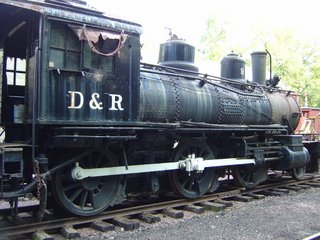

Beyond D&R #9, at the very end of the last siding before it merges back with the main line which disappears into the trees around a bend; is the half-disassembled Chicago & Northwestern Class R-1 4-6-0 #1385 and its tender. #1385 was the pride of Mid-Continent for more than three decades before the locomotive was found to need major boiler and firebox reconstruction. It was for all practical purposes retired indefinitely in 1998, as progress has been extremely slow.
Here is #1385 doing what it did best during our first visit to MCRM in 1992:
Front
Side
Cab
Tender
#1385 was briefly taken out of service in 1994 so its running gear could be removed and repaired, but that was nothing compared to the eight-year (and counting) hiatus it is currently in.
1385 sans wheels in 1994
#1385 sans cab, smokebox cover and numerous other parts in 2006:

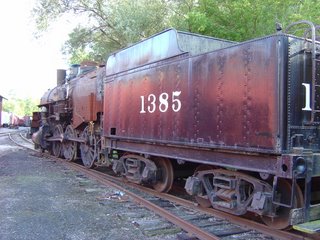

Now heading back north toward the depot on the east side of the maintenance sheds, we come across Mid-Continent's several disassembled locomotives, which either came to the museum on the verge of scrapping or were taken apart for a restoration that was never completed. The boiler and cab below belong to Louisiana Cypress 2-6-0 Mogul type #2 and the saddle tank behind the boiler is part of CIPS #6, an 0-4-0 switcher.
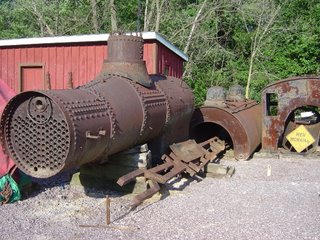

These six wheels might belong to either L.C. #2 or Western Coal & Coke #1, not sure which.
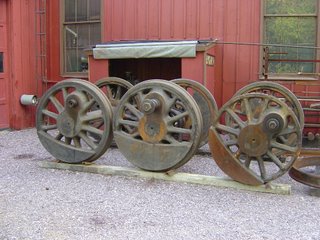
Nearby I found the smokebox cover for #1385, propped up against one of the boxcars converted to storage sheds.
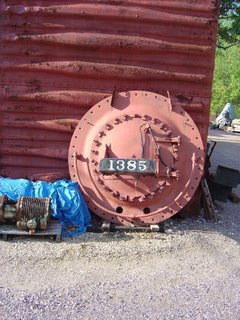
The final exhibit I photographed at Mid-Continent, Wisconsin Sand & Gravel #2, a gasoline-engine switcher built in 1928.

Conspicously absent from the museum was any sign of Saginaw Timber Company (now Polson Bros. Logging Company) 2-8-2 Mikado type #2, another of their formerly operable steam locomotives. I may have spotted its wheels under a tarp near the old freight car storage tracks, but I'm not sure.
We couldn't help but notice the engraving on the base of this old water-heating cauldron. It's probably not a relation, my dad was an only child and most of his father's siblings never had children.



Another exhibit that caught my attention (and fit in with the later theme of the day) was this 7 1/2" gauge steam locomotive, Southern Pacific 4-6-2 #7982. This is about as small as trains can get and still be rideable-the driver rides astraddle a cushion on top of the tender and operates the engine through the cutout in the roof of the cab. This particular locomotive is fired on propane gas from a tank in the tender. It is quite detailed, right down to the AAR (American Association of Railroads) engraved on the couplers, and miniature American Locomotive Company builder's plates.




After leaving the Badger Steam & Gas Engine show, I suggested that we make the trip to the Mid-Continent Railroad Museum just down the road, which we hadn't done since 1994 (when I was 8). The museum is headquartered at the former North Freedom depot, and the exhibits stretch off in both directions down the ex-Chicago & Northwestern branch line from North Freedom to Quartzite Lake.

One of the first things you notice upon arrival at the museum is Soo Line #2645, a Brooks Locomotive Works 4-6-0. It was recently cosmetically restored and its black paint fairly gleams.


A close-up of one of #2645's Brooks builder's plates:

#2645's ALCO reversing gear:

Another of Mid-Continent's more prominently placed exhibits is this undercoat dull-red 2-8-0 Consolidation type, Copper Range #29. #29 is an ALCO product from 1907 and is on display in front of the Coach Shed on the south side of the street.



Parked directly in front of the depot is Mid-Continent's four-a-day excursion train, including Duluth, Missabe & Iron Range caboose #C74.

Also on display close to the depot is Kewaunee, Green Bay & Western 2-8-0 Consolidation #49. #49 is the only surviving steam locomotive from that railroad. It has received a new coat of paint since the last times I saw it in 1992 and 1994, although its bell and headlight have mysteriously gone missing.



In between the main line on which the passenger train is parked and the display tracks that contain #2645 and #49 is this Dodge car modified to run on railroad tracks; together with a maintenance-of-way vehicle behind it. We photographed this car with our late Cairn terrier Harry in 1992.

Farther down the tracks on the depot (north) side of the street are two more steam locomotives on display. One is Mid-Continent's only Shay locomotive, recently cosmetically restored Goodman Lumber #9. Instead of chassis-mounted cylinders that drive the wheels directly via connecting rods, Shays have a steam engine mounted vertically on the side that drives the wheels through a system of shafts and bevel gears.


Close to the Shay is the only decrepit-looking locomotive on the north end of the museum. Woodward Iron #41, a Baldwin 2-10-0, is also the largest, heaviest and probably most powerful steam locomotive on display at MCRM.


This is a steam-powered rotary snowplow from the Oregon Short Line. It contains a control cab, boiler and steam engine and requires a tender for fuel and water...but is not self-propelled and requires a locomotive to push it along.

Immediately on the opposite (south) side of the street from the depot are the water tower and Coach Shed (with CR #29 in front). Close to the water tower are several freight cars on display, including a Soo Line ore car, UTLX tank car, and two steam locomotive tenders including that for Western Coal & Coke #1.



Much of Mid-Continent's fully restored rolling stock collection is protected from the elements inside the Coach Shed, including this handcar and late-19th century Soo Line boxcar.


Beyond the coach shed are several tracks containing most of the museum's unrestored and work-in-progress exhibits, as well as the locomotive maintenance and storage sheds.
A row of unmarked freight cars. The one closest to the caboose is a refrigerator car.

This ALCO S-1 diesel-electric switcher locomotive, lettered MCRY #7, is currently Mid-Continent's primary motive power.



This General Electric switcher, lettered MCRY #4, is used around the Museum grounds to move rolling stock between the various sheds and display tracks.


Outside the maintenance sheds is Lake Superior & Ishpeming #22, an ALCO 2-8-0 Consolidation. It is a privately owned locomotive being stored at Mid-Continent for restoration.



Moving further south down the myriad of storage sidings on the west side of the maintenance sheds, one comes across the largest diesel road locomotive on display at MCRM, Milwaukee Road ALCO RSC-2 #988. Diesel locomotives can be classified by their wheel arrangements like steam locomotives but the system is somewhat different. The AAR wheel configuration counts axles instead of wheels, using letters for powered axles, numbers for idler axles, and dashes to seperate trucks (swivelling wheel assemblies). #988 is an A1A-A1A locomotive, meaning the center axle on each truck is unpowered. MCRY #7 above is a B-B, meaning it has two trucks each with both axles powered.
During our trip to MCRM in 1994, the eight-year-old me was photographed on the platform of this locomotive.


Parked next to #988 is a Soo Line crane car with flat car.

Beyond Milwaukee #988 is the oldest locomotive in MCRM's collection, Dardanelle & Russellville 2-6-0 Mogul #9. It was built in 1884 and served as the flagship of Mid-Continent's collection in the museum's early years of operation. It last ran in 1991 and has since deteriorated below operational condition, although it does appear to be the most complete and intact steam locomotive on the south end of the museum.



Beyond D&R #9, at the very end of the last siding before it merges back with the main line which disappears into the trees around a bend; is the half-disassembled Chicago & Northwestern Class R-1 4-6-0 #1385 and its tender. #1385 was the pride of Mid-Continent for more than three decades before the locomotive was found to need major boiler and firebox reconstruction. It was for all practical purposes retired indefinitely in 1998, as progress has been extremely slow.
Here is #1385 doing what it did best during our first visit to MCRM in 1992:
Front
Side
Cab
Tender
#1385 was briefly taken out of service in 1994 so its running gear could be removed and repaired, but that was nothing compared to the eight-year (and counting) hiatus it is currently in.
1385 sans wheels in 1994
#1385 sans cab, smokebox cover and numerous other parts in 2006:



Now heading back north toward the depot on the east side of the maintenance sheds, we come across Mid-Continent's several disassembled locomotives, which either came to the museum on the verge of scrapping or were taken apart for a restoration that was never completed. The boiler and cab below belong to Louisiana Cypress 2-6-0 Mogul type #2 and the saddle tank behind the boiler is part of CIPS #6, an 0-4-0 switcher.


These six wheels might belong to either L.C. #2 or Western Coal & Coke #1, not sure which.

Nearby I found the smokebox cover for #1385, propped up against one of the boxcars converted to storage sheds.

The final exhibit I photographed at Mid-Continent, Wisconsin Sand & Gravel #2, a gasoline-engine switcher built in 1928.

Conspicously absent from the museum was any sign of Saginaw Timber Company (now Polson Bros. Logging Company) 2-8-2 Mikado type #2, another of their formerly operable steam locomotives. I may have spotted its wheels under a tarp near the old freight car storage tracks, but I'm not sure.


0 Comments:
Post a Comment
<< Home